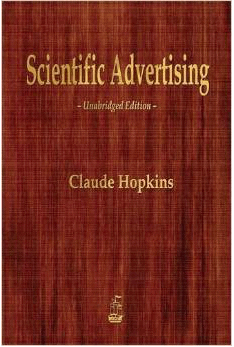This 97-year-old book about advertising is more relevant than ever

One reason I never made it as a professional orchestra musician is that I treated the French Horn like a never-ending brain puzzle. “What does this melody mean?!” I would ponder to myself fifty times a day as I sat in a windowless practice room.
Whenever auditions rolled around, I was thinking more about symbols and narratives I had created in my head than playing the right notes in the right order.
Again and again, I would get my butt whipped by peers who never thought about hero/villain metaphors, but could ace a solo in the middle of a hailstorm if you wanted them to.
I resented these musical jocks, their one-track meathead minds, and their unshakeable confidence.
The deeper reason I resented them was because I hated myself and my tendency to overthink. My fellow musicians’ mastery of the basics was what helped them sail through, and this fluency often made them the most effective and expressive players in the room.
In leaving music conservatory broken and bruised (And with a $55,000 bill from my student loan providers), I feverishly worked to learn new skills that could make me employable.
I looked online for reading recommendations and devoured every book I could on the topics of writing and marketing.
And one book written nearly a century ago was recommended again and again in online forums and by successful internet personalities: Scientific Advertising by Claude Hopkins.

The 97-year-old book about advertising that’s more relevant than ever
Scientific Advertising by Claude Hopkins spawned a new era in writing and marketing. Lauded by many legendary marketers and copywriters of the 20th century, including agency king David Ogilvy and legendary copywriter Gary Halbert, its message has only become more relevant in the digital age.
When it comes to influence and sales, the pillars of persuasion outlined in Scientific Advertising have remained largely the same over a hundred years. (The book is also public domain and you can read it in its entirety for free.)
While controversy still brews over whether our attention spans have actually shortened, opportunities to fracture our concentration — whether they be endless social media feeds or nagging push notifications — have arisen with the proliferation of the smartphone.
Writers are now tasked with capturing the undivided attention of readers faster than ever before, so here are 5 important points from Scientific Advertising that still apply nearly a century later.

Scientific Advertising Takeaway #1: Clarity trumps persuasion
“Fine talkers are rarely good salesmen.” — Claude Hopkins
It can be tempting to slide into industry jargon or fancy language, but often this attempt to come off as smart or commanding backfires.
When your reader has to strain to keep up, they lose interest and move on; it’s on you to keep them engaged. An example shown in Scientific Advertising displays the following advert from Mead Cycle Company:
“Try before you buy. Select the bicycle you prefer from the 44 styles, colors and sizes in the famous “Ranger” line. We send it on approval and 30 DAYS TRIAL, freight paid to your town. Return if not pleased and the trial costs you nothing.”
So boring. But so clear! The owner of Mead Cycle Company found this iteration of his ad so lucrative he didn’t change a single word.
Add charm or detail later; your first objective in tighter writing is to communicate the value proposition quickly and well.
Scientific Advertising Takeaway #2: Find ways to gauge reader interest
We’re blessed to have a tremendous number of feedback loops on writing at our fingertips, such as page views on a website, book sales, or email newsletter opens. Use these metrics to improve your writing.
Scientific Advertising was one of the earliest books to tout the benefits of split testing, in which you test two or more variables in a marketing campaign.
For most writers, their first encounter with split testing is in email marketing; most email list software will allow you to send different subject lines of the same newsletter to your list, which lets you see which subject line gets a better engagement rate.
Mr. Hopkins measured feedback through coupon redemption rates and tracked phone calls. You only have to press a few buttons to create a similar feedback loop. Harvest this feedback, then do more of what works.
Scientific Advertising Takeaway #3: Know how human brains are wired
Human motivation hasn’t changed much over the last hundred years. This is good news for us, because as Mr. Hopkins notes, once you learn principles of human psychology you’ll never have to unlearn them.
A few writing tactics particularly lauded in chapter six of Scientific Advertising include:
Curiosity
Pique interest with unexpected and exciting details to get your reader more emotionally invested in your work.
Guarantees
Humans are defensive; the opportunity to try a product risk-free erodes natural defense mechanisms in a buyer’s mind.
Samples
In a series of fascinating examples, Hopkins found that when advertisements were structured for the consumer to take initiative on getting a free sample, rather than a spokesperson pandering samples to anyone who will listen, engagement improved.
Mattress company Nectar uses the psychology of guarantee to great effect. When Nectar wants to sell you a mattress, they offer you a 365-day trial, more than 3 times their industry competitors.
One version of their advert headline reads: “Which of these sounds better to you, a 100-day trial or a 365-day trial?” Nectar also uses the tagline “Take a year”. It’s a simple, emotionally arresting jingle rooted in psychology.
Even as photography, videography, and other forms of content production rise in popularity, these psychological triggers run the show behind the scenes and are delivered well through writing.
Scientific Advertising Takeaway #4: Relieve the tension I experience now
The unfortunate truth is that it’s much easier to identify a consumer’s pain and offer to remove it than it is to encourage precautionary measures. This doesn’t mean you have to be all doom and gloom, but you do want to elicit tension in some way when writing for others.
Many of Scientific Advertising’s examples still apply today. Toothpaste ads that promise whiter teeth outperform ones that tout the continued prevention of cavities. Soaps that promise more radiant, glowing skin will always outperform a headline like “keep clean”.
To encourage readers to act now and not later, focus on present-day inconveniences and how your product, program or service alleviates that trouble.
Scientific Advertising Takeaway #5: Stories feel familiar
“What matters isn’t storytelling. What matters is telling a true story well.” — Ann Handley
A Nielsen report found that Americans spend an astonishing 11 hours and 27 minutes each day consuming media, a number that has risen year after year. That’s because media prioritizes stories and stories captivate us, whether we’re paying with our dollars or our time.
Mr. Hopkins notes that it’s an advertiser’s job to sell a complete story or proposition within a single ad, and then let the consumer decide if they are for or against the proposition.
Hopkins notes that, at $10 a word (about $151/word in today’s dollar), every word has to be a “super-salesman”. It sounds like every word also has to be a “super-storyteller”.
Whether you’re writing articles, social media captions, or advertisements, see if you can thread story into your writing.
No matter your industry of expertise, it’s a valuable use of time to learn and master the strategies that persuade people to click and read. The principles in Scientific Advertising are timeless, proven, and a tactic you can start putting in place for free today.
This article was originally written for Entrepreneur.com. Copyright 2020 by Entrepreneur Media, Inc. All rights reserved.
Want to free mental clutter, write faster, and get your articles published on international websites?
I’ve put my exact outline and best tips that get me published in places like Entrepreneur.com and Business Insider into a 10-page PDF for easy reference.
Grab the free PDF right here.

